KIA Sorento 2006 1.G Owner's Manual
Manufacturer: KIA, Model Year: 2006, Model line: Sorento, Model: KIA Sorento 2006 1.GPages: 312, PDF Size: 5.21 MB
Page 231 of 312
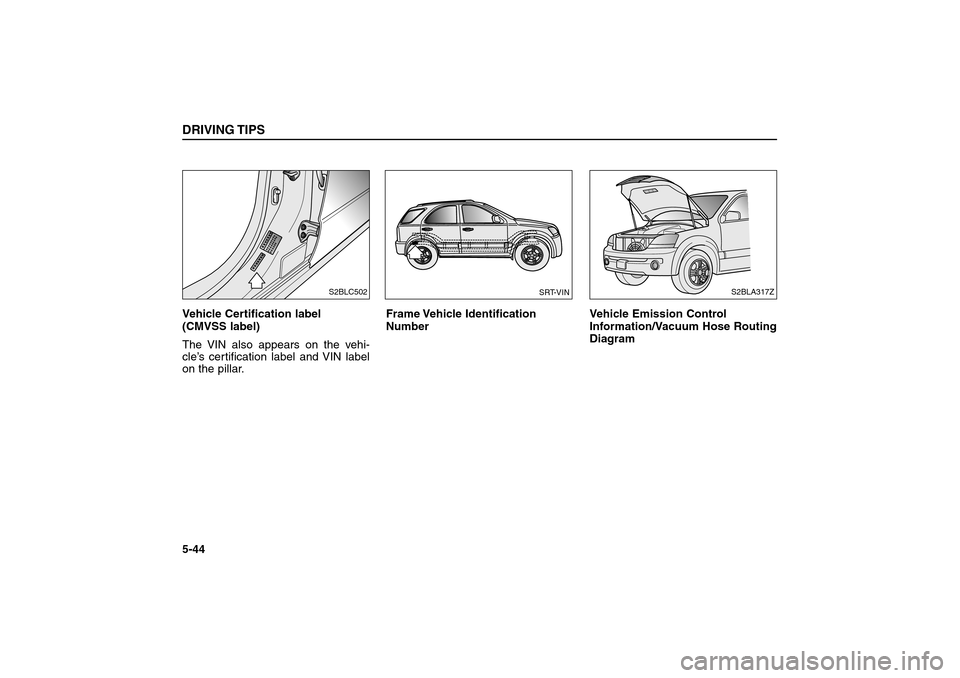
Vehicle Certification label
(CMVSS label)
The VIN also appears on the vehi-
cle’s certification label and VIN label
on the pillar.Frame Vehicle Identification
Number Vehicle Emission Control
Information/Vacuum Hose Routing
DiagramDRIVING TIPS5-44
xxxx
xxxx xxxx
xxxx xxxx
xxxx
S2BLA317Z
SRT-VIN
S2BLC502
BL-ENG (CAN)-5.qxd 7/28/05 5:56 PM Page 44
Page 232 of 312
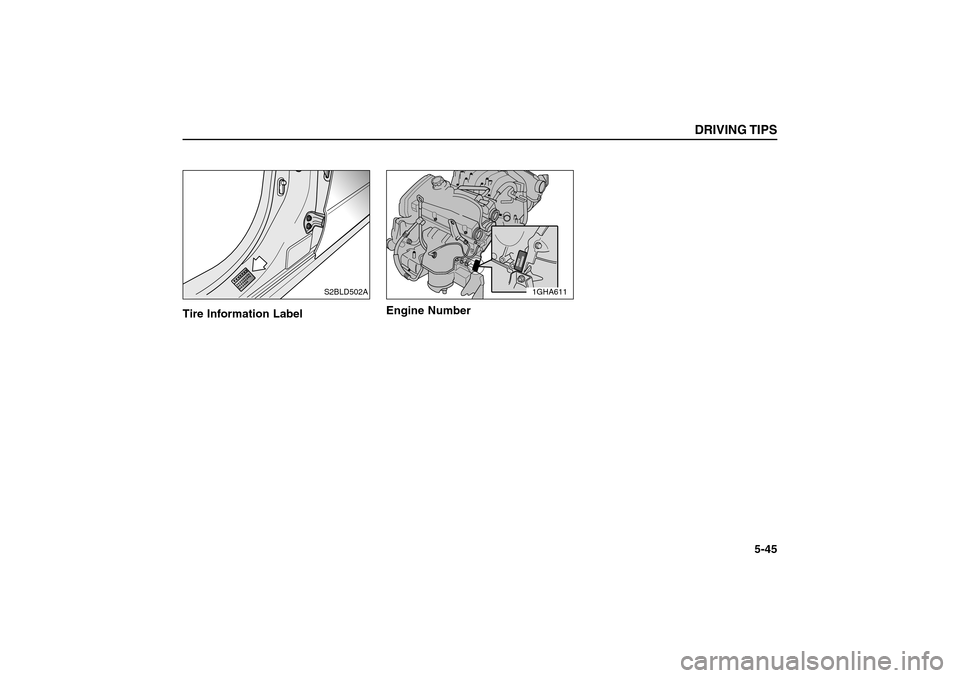
Tire Information LabelEngine Number
DRIVING TIPS
5-45
S2BLD502A
1GHA611
BL-ENG (CAN)-5.qxd 7/28/05 5:56 PM Page 45
Page 233 of 312
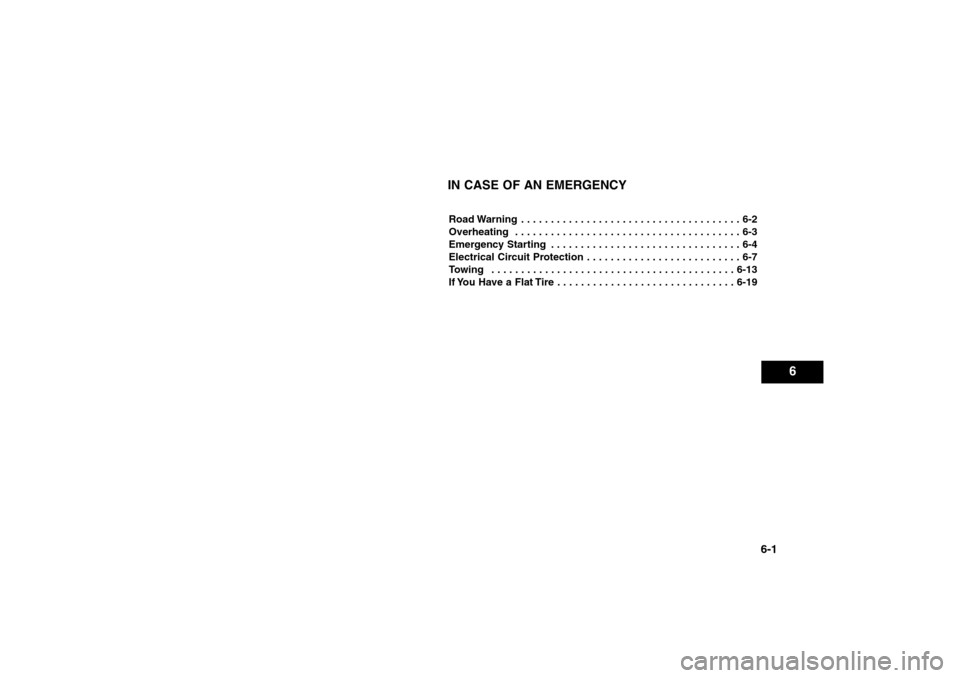
6-1
IN CASE OF AN EMERGENCYRoad Warning . . . . . . . . . . . . . . . . . . . . . . . . . . . . . . . . . . . . . 6-2
Overheating . . . . . . . . . . . . . . . . . . . . . . . . . . . . . . . . . . . . . . 6-3
Emergency Starting . . . . . . . . . . . . . . . . . . . . . . . . . . . . . . . . 6-4
Electrical Circuit Protection . . . . . . . . . . . . . . . . . . . . . . . . . . 6-7
Towing . . . . . . . . . . . . . . . . . . . . . . . . . . . . . . . . . . . . . . . . . 6-13
If You Have a Flat Tire . . . . . . . . . . . . . . . . . . . . . . . . . . . . . . 6-19
6
BL-ENG (CAN)-6.qxd 7/28/05 5:57 PM Page 1
Page 234 of 312
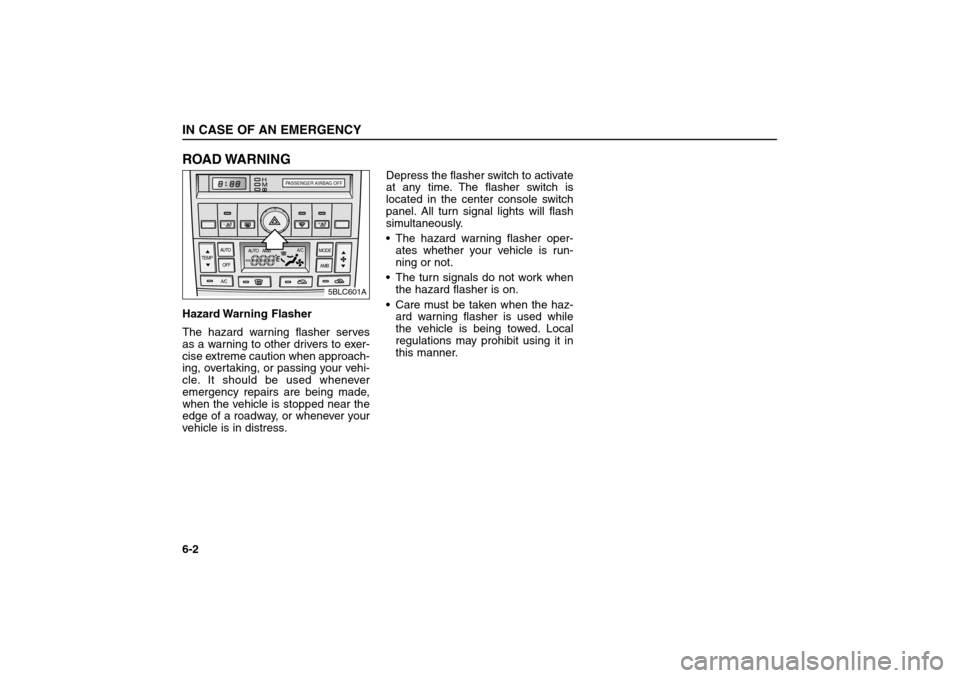
ROAD WARNINGHazard Warning Flasher
The hazard warning flasher serves
as a warning to other drivers to exer-
cise extreme caution when approach-
ing, overtaking, or passing your vehi-
cle. It should be used whenever
emergency repairs are being made,
when the vehicle is stopped near the
edge of a roadway, or whenever your
vehicle is in distress.Depress the flasher switch to activate
at any time. The flasher switch is
located in the center console switch
panel. All turn signal lights will flash
simultaneously.
• The hazard warning flasher oper-
ates whether your vehicle is run-
ning or not.
The turn signals do not work when
the hazard flasher is on.
Care must be taken when the haz-
ard warning flasher is used while
the vehicle is being towed. Local
regulations may prohibit using it in
this manner.IN CASE OF AN EMERGENCY6-2
AU TO
AUTO AMB
OFF TEMPMODE
AMB
A/C
A/C
L
R
H
M
PASSENGER AIRBAG OFF
5BLC601A
BL-ENG (CAN)-6.qxd 7/28/05 5:57 PM Page 2
Page 235 of 312
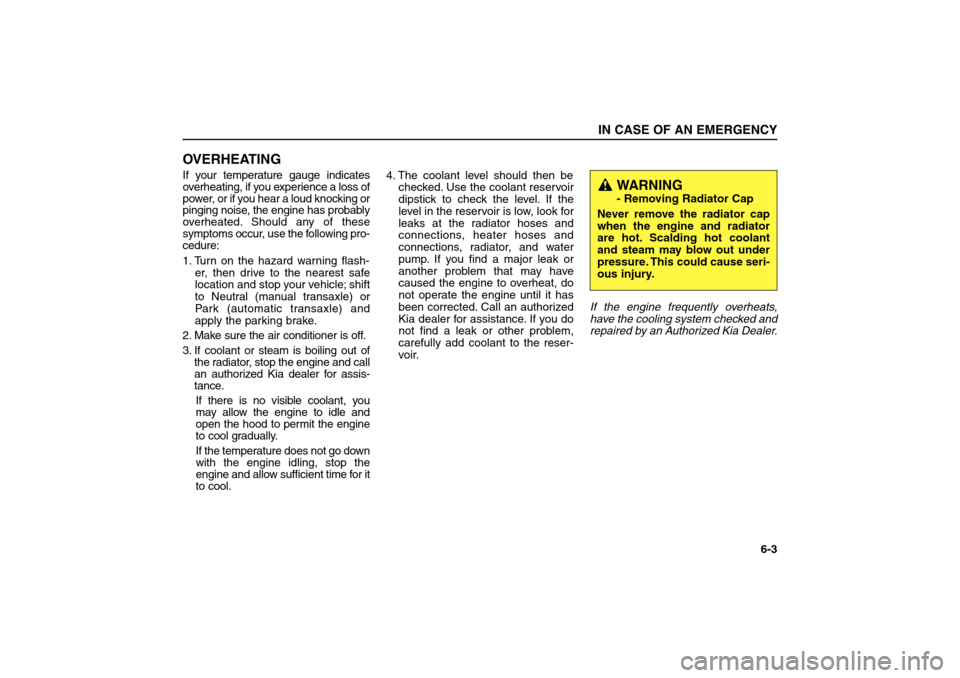
OVERHEATINGIf your temperature gauge indicates
overheating, if you experience a loss of
power, or if you hear a loud knocking or
pinging noise, the engine has probably
overheated. Should any of these
symptoms occur, use the following pro-
cedure:
1. Turn on the hazard warning flash-
er, then drive to the nearest safe
location and stop your vehicle; shift
to Neutral (manual transaxle) or
Park (automatic transaxle) and
apply the parking brake.
2. Make sure the air conditioner is off.
3. If coolant or steam is boiling out of
the radiator, stop the engine and call
an authorized Kia dealer for assis-
tance.
If there is no visible coolant, you
may allow the engine to idle and
open the hood to permit the engine
to cool gradually.
If the temperature does not go down
with the engine idling, stop the
engine and allow sufficient time for it
to cool.4. The coolant level should then be
checked. Use the coolant reservoir
dipstick to check the level. If the
level in the reservoir is low, look for
leaks at the radiator hoses and
connections, heater hoses and
connections, radiator, and water
pump. If you find a major leak or
another problem that may have
caused the engine to overheat, do
not operate the engine until it has
been corrected. Call an authorized
Kia dealer for assistance. If you do
not find a leak or other problem,
carefully add coolant to the reser-
voir.If the engine frequently overheats,
have the cooling system checked and
repaired by an Authorized Kia Dealer.
IN CASE OF AN EMERGENCY
6-3
WARNING- Removing Radiator Cap
Never remove the radiator cap
when the engine and radiator
are hot. Scalding hot coolant
and steam may blow out under
pressure. This could cause seri-
ous injury.
BL-ENG (CAN)-6.qxd 7/28/05 5:57 PM Page 3
Page 236 of 312
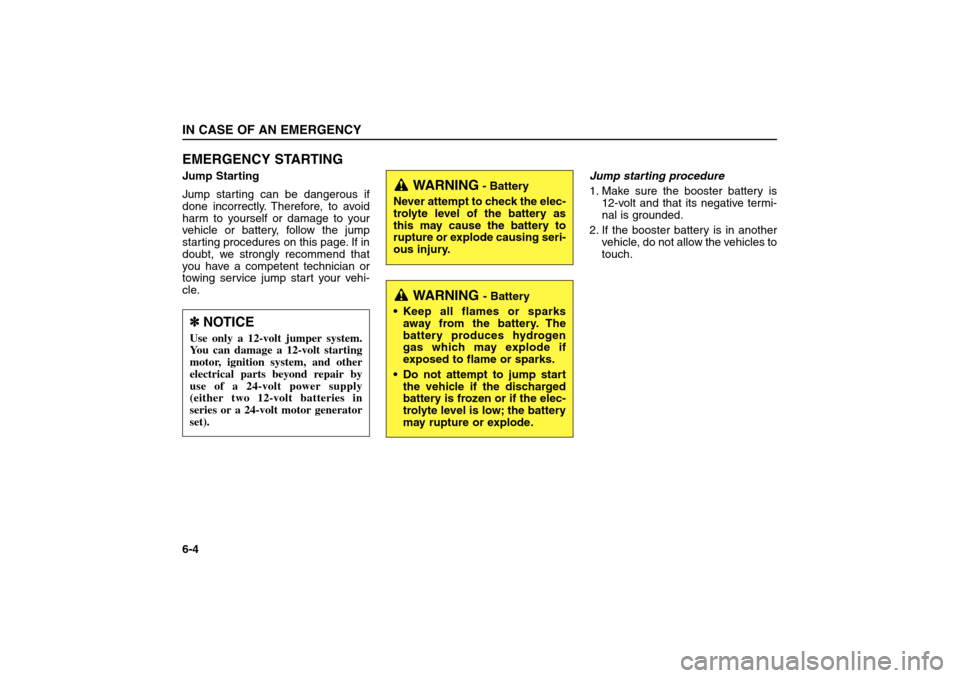
EMERGENCY STARTINGJump Starting
Jump starting can be dangerous if
done incorrectly. Therefore, to avoid
harm to yourself or damage to your
vehicle or battery, follow the jump
starting procedures on this page. If in
doubt, we strongly recommend that
you have a competent technician or
towing service jump start your vehi-
cle.Jump starting procedure
1. Make sure the booster battery is
12-volt and that its negative termi-
nal is grounded.
2. If the booster battery is in another
vehicle, do not allow the vehicles to
touch.IN CASE OF AN EMERGENCY6-4✽ ✽
NOTICEUse only a 12-volt jumper system.
You can damage a 12-volt starting
motor, ignition system, and other
electrical parts beyond repair by
use of a 24-volt power supply
(either two 12-volt batteries in
series or a 24-volt motor generator
set).
WARNING
- Battery
Never attempt to check the elec-
trolyte level of the battery as
this may cause the battery to
rupture or explode causing seri-
ous injury.
WARNING
- Battery
• Keep all flames or sparks
away from the battery. The
battery produces hydrogen
gas which may explode if
exposed to flame or sparks.
Do not attempt to jump start
the vehicle if the discharged
battery is frozen or if the elec-
trolyte level is low; the battery
may rupture or explode.
BL-ENG (CAN)-6.qxd 7/28/05 5:57 PM Page 4
Page 237 of 312
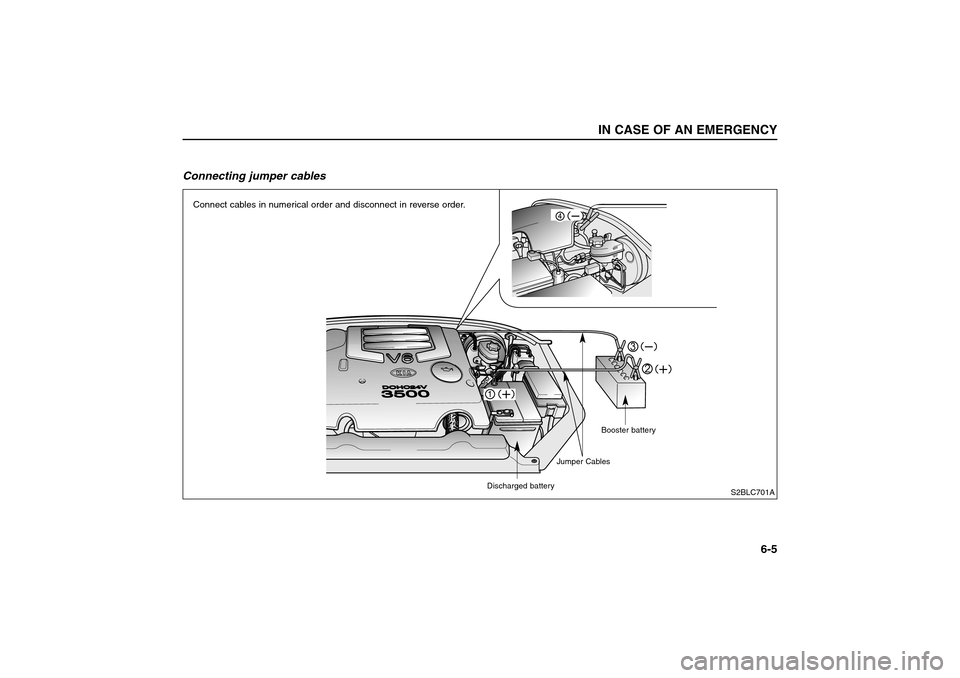
Connecting jumper cables
IN CASE OF AN EMERGENCY
6-5
S2BLC701A
Connect cables in numerical order and disconnect in reverse order.
Discharged battery
Jumper Cables
Booster battery
BL-ENG (CAN)-6.qxd 7/28/05 5:57 PM Page 5
Page 238 of 312
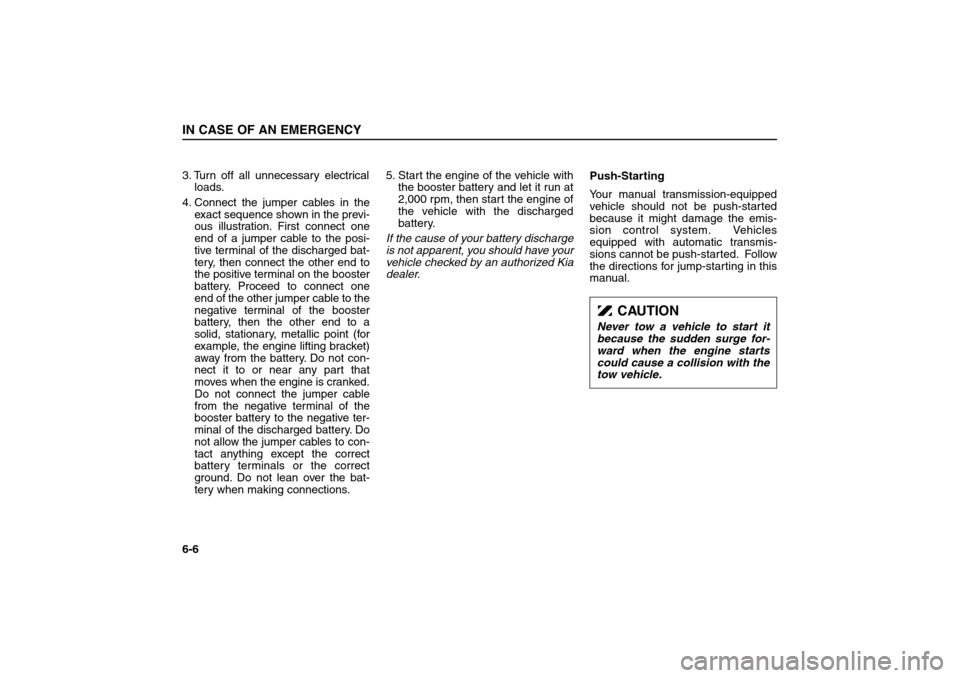
3. Turn off all unnecessary electrical
loads.
4. Connect the jumper cables in the
exact sequence shown in the previ-
ous illustration. First connect one
end of a jumper cable to the posi-
tive terminal of the discharged bat-
tery, then connect the other end to
the positive terminal on the booster
battery. Proceed to connect one
end of the other jumper cable to the
negative terminal of the booster
battery, then the other end to a
solid, stationary, metallic point (for
example, the engine lifting bracket)
away from the battery. Do not con-
nect it to or near any part that
moves when the engine is cranked.
Do not connect the jumper cable
from the negative terminal of the
booster battery to the negative ter-
minal of the discharged battery. Do
not allow the jumper cables to con-
tact anything except the correct
battery terminals or the correct
ground. Do not lean over the bat-
tery when making connections.5. Start the engine of the vehicle with
the booster battery and let it run at
2,000 rpm, then start the engine of
the vehicle with the discharged
battery.
If the cause of your battery discharge
is not apparent, you should have your
vehicle checked by an authorized Kia
dealer.Push-Starting
Your manual transmission-equipped
vehicle should not be push-started
because it might damage the emis-
sion control system. Vehicles
equipped with automatic transmis-
sions cannot be push-started. Follow
the directions for jump-starting in this
manual.IN CASE OF AN EMERGENCY6-6
CAUTION
Never tow a vehicle to start it
because the sudden surge for-
ward when the engine starts
could cause a collision with the
tow vehicle.
BL-ENG (CAN)-6.qxd 7/28/05 5:57 PM Page 6
Page 239 of 312
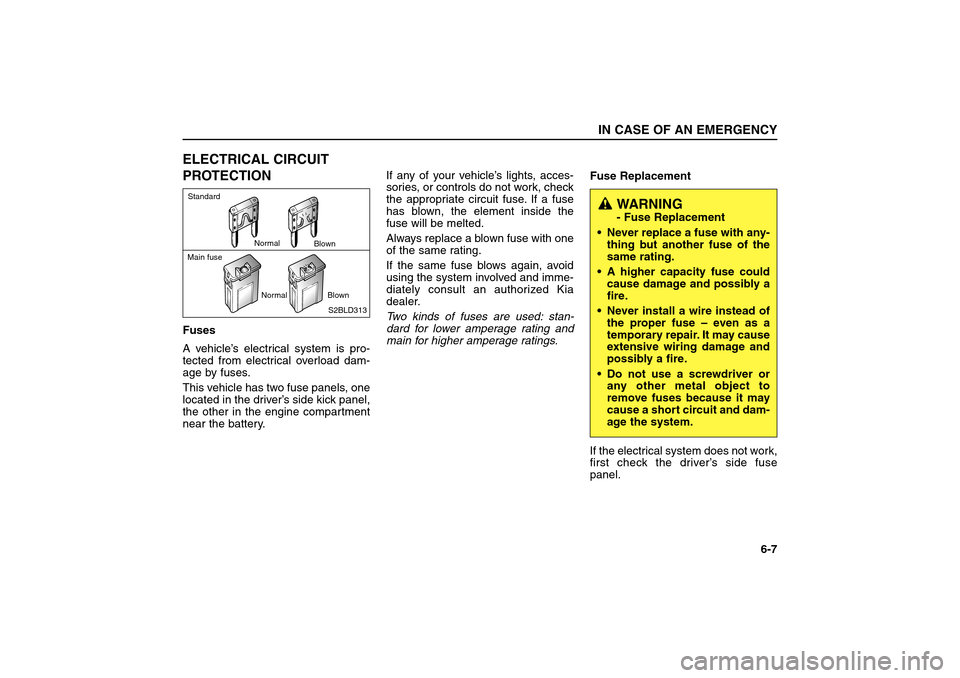
ELECTRICAL CIRCUIT
PROTECTIONFuses
A vehicle’s electrical system is pro-
tected from electrical overload dam-
age by fuses.
This vehicle has two fuse panels, one
located in the driver’s side kick panel,
the other in the engine compartment
near the battery.If any of your vehicle’s lights, acces-
sories, or controls do not work, check
the appropriate circuit fuse. If a fuse
has blown, the element inside the
fuse will be melted.
Always replace a blown fuse with one
of the same rating.
If the same fuse blows again, avoid
using the system involved and imme-
diately consult an authorized Kia
dealer.
Two kinds of fuses are used: stan-
dard for lower amperage rating and
main for higher amperage ratings.Fuse Replacement
If the electrical system does not work,
first check the driver’s side fuse
panel.
IN CASE OF AN EMERGENCY
6-7
S2BLD313
StandardMain fuseNormal
Blown
NormalBlown
WARNING- Fuse Replacement
Never replace a fuse with any-
thing but another fuse of the
same rating.
A higher capacity fuse could
cause damage and possibly a
fire.
Never install a wire instead of
the proper fuse – even as a
temporary repair. It may cause
extensive wiring damage and
possibly a fire.
Do not use a screwdriver or
any other metal object to
remove fuses because it may
cause a short circuit and dam-
age the system.
BL-ENG (CAN)-6.qxd 7/28/05 5:57 PM Page 7
Page 240 of 312
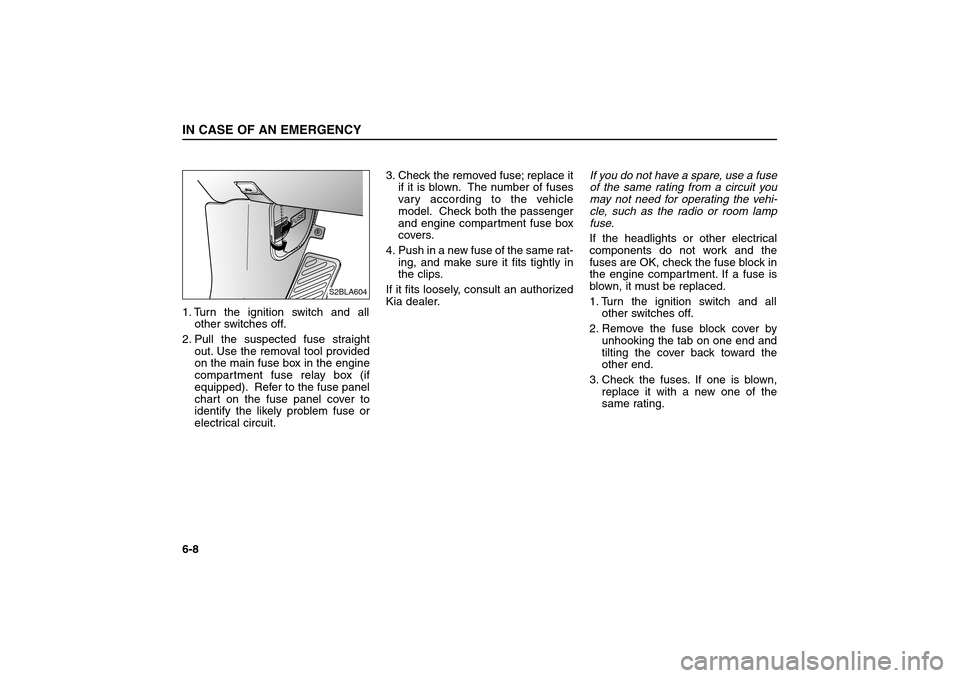
1. Turn the ignition switch and all
other switches off.
2. Pull the suspected fuse straight
out. Use the removal tool provided
on the main fuse box in the engine
compartment fuse relay box (if
equipped). Refer to the fuse panel
chart on the fuse panel cover to
identify the likely problem fuse or
electrical circuit.3. Check the removed fuse; replace it
if it is blown. The number of fuses
vary according to the vehicle
model. Check both the passenger
and engine compartment fuse box
covers.
4. Push in a new fuse of the same rat-
ing, and make sure it fits tightly in
the clips.
If it fits loosely, consult an authorized
Kia dealer.If you do not have a spare, use a fuse
of the same rating from a circuit you
may not need for operating the vehi-
cle, such as the radio or room lamp
fuse.
If the headlights or other electrical
components do not work and the
fuses are OK, check the fuse block in
the engine compartment. If a fuse is
blown, it must be replaced.
1. Turn the ignition switch and all
other switches off.
2. Remove the fuse block cover by
unhooking the tab on one end and
tilting the cover back toward the
other end.
3. Check the fuses. If one is blown,
replace it with a new one of the
same rating.IN CASE OF AN EMERGENCY6-8
FUSE
S2BLA604
BL-ENG (CAN)-6.qxd 7/28/05 5:57 PM Page 8